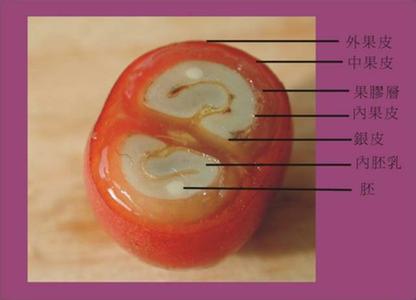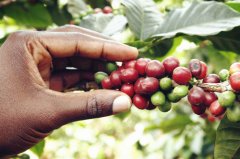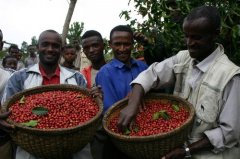How are coffee beans removed?
Boutique coffee (specialty coffee) is also called "specialty coffee" or "select coffee". It refers to coffee made from a small number of raw beans with excellent taste grown in an ideal geographical environment. Depending on the special soil and climatic conditions in which they grow, they have outstanding flavor. After strict selection and classification, this kind of coffee can be regarded as a selection of coffee beans because of its hard texture, rich taste and excellent flavor.
The picking of coffee beans
Coffee beans are the seeds of coffee trees. After three or four years of growth, the coffee tree matures and begins to bear fruit, with one fruit arranged in clusters or clusters along the branches. The outside of the seed is a layer of peel, which can be picked as soon as it turns red. Under the red skin (exocarp) there is a layer of pulp (mesocarp), which is a small thin layer, and then a layer of parchment-like substance-endocarp. In all of these peels, there are usually two beans with opposite planes, and the beans have a thin film or skin on the outside.
Most Arabica coffee beans mature from June to August and Robart coffee beans from September to October. Therefore, although in some countries where the dry and wet seasons are not obvious, such as Colombia and Kenya, there are two flowering periods a year, that is, two harvests, strictly speaking, only once a year.
Due to different regions, the harvest time is also different. Regions north of the equator (such as Ethiopia and Central America) are generally harvested from September to November. South of the equator, such as Brazil and Zimbabwe (Zimbabwe), although the harvest can last until August, the main one is in April or May. Countries in the equatorial region, such as Uganda (Uganda) and Colombia, can harvest all year round, especially those plantations that make good use of different elevations. As a result, there may be new coffee beans for most of the year.
As far as picking itself is concerned, there are two ways: one is picking in pieces, that is, picking all the beans in a single walk in the garden, and the other is selective picking, that is, walking through the trees a few times and picking only the ripe red berries at intervals of 10 days. Selective picking is more expensive and labor-intensive than picking in pieces, and it is generally only used for Arabica coffee beans, especially those that need to be washed.
The number of coffee beans picked depends on a variety of factors, the most obvious being the height of the trees and the layout of the farm or plantation. The average farm can pick an average of 50 kilograms per picker a day. But only 20% of these weights are real coffee beans, so the average picker can only pick 10Mel 20 kilograms of coffee beans. The coffee beans are packed in a bag with a standard weight of 45ml and 60kg. As a result, it takes a worker six days to fill a bag.
It has been calculated that the cost of harvesting a plantation or farm is half of the total cost of the year. In Brazil, people have tried many times to reduce these costs by mechanical picking. The machine can shake branches across the coffee tree so that the berries that become loose because they are ripe will fall into the funnel. Mechanical pickers only work in areas with better natural conditions, and they need to be adjusted in advance, because they can only be used where the trees can be planted in rows straight, and afterwards need to check the coffee beans picked by the machine. pick out the leaves and branches that have fallen in the funnel.
Therefore, a large part of the coffee is picked by hand, which requires a lot of seasonal work, and pickers should be careful not to pick coffee beans that are not ripe, bad or too ripe, as they will affect the overall quality of the coffee harvested. Coffee beans that are not so good are classified as "ordinary", "sour" or "fermented", and the last one is very bad.

Important Notice :
前街咖啡 FrontStreet Coffee has moved to new addredd:
FrontStreet Coffee Address: 315,Donghua East Road,GuangZhou
Tel:020 38364473
- Prev

Ten keys to the selection of coffee raw beans for fine coffee
Boutique coffee (specialty coffee) is also called specialty coffee selection coffee. It refers to coffee made from a small number of raw beans with excellent taste grown in an ideal geographical environment. Depending on the special soil and climatic conditions in which they grow, they have outstanding flavor. After strict selection and classification, this kind of coffee is hard in texture, rich in taste and stylish.
- Next

Coffee beans are processed by drying.
Fine coffee beans must be good quality beans without blemishes. It should have outstanding flavor, not without bad taste, but taste particularly good, coffee bean processing coffee beans refined processing about rough processing, separation, classification, fermentation, drying, shelling, polishing, classification, etc. 8 procedures. There are two ways to prepare coffee beans for the roasting process. The method chosen for coffee
Related
- Guji coffee producing area of Guji, Ethiopia: Humbela, Shakiso, Wulaga
- What is the most expensive variety of Qiloso in BOP multi-variety group?
- How to store the coffee beans bought home?
- Why are Yemeni coffee beans so rare now?
- Ethiopian Sidamo all Red Fruit Sun Sun Santa Vini Coffee beans
- SOE is mostly sour? What does it mean? Is it a single bean? what's the difference between it and Italian blending?
- Is Italian coffee beans suitable for making hand-brewed coffee?
- How to choose coffee beans when making cold coffee? What kind of coffee beans are suitable for making cold coffee?
- Just entered the pit to make coffee, what kind of coffee beans should be chosen?
- Can only Japan buy real Blue Mountain Coffee? What are authentic Jamaican Blue Mountain coffee beans?

